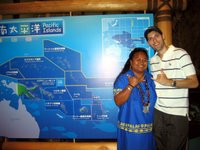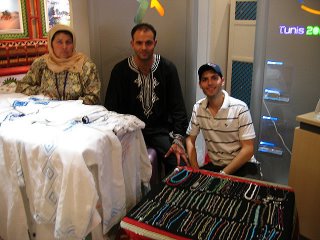“Nature’s Wisdom,” the Expo’s environmental theme, was lost on most visitors, and perhaps the organizers themselves. Forests outside of Nagoya, home to the endangered goshawk and Gifu butterfly, were felled to pave the way for the sprawling 462-acre complex. 22 million visitors flocked to the Expo during its six months of operation. By comparison, New York City attracted 38 million tourists and Britain 28 million in all of 2004. On the Sunday I visited, it felt like all 22 million also showed up.
The hottest tickets were for corporate pavilions like Toyota, Hitachi, and Mitsui-Toshiba that showcased the technology of tomorrow: a robot music band, one-person concept car(“i-unit”), and movies featuring digitized faces of the audience. Never underestimate the patience of this race. The Japanese came prepared with folding chairs, picnic blankets, hand-held video games, and playing cards to queue up to six hours. I wouldn’t wait half that long to meet the Pope, president, or anyone else for that matter, and certainly not for a 20-minute show.
Plenty of alternative exhibits entertained this former geography major. From Angola to Zimbabwe, pavilions for 121 nations displayed Disneyified renditions of world cultures. A more authentic experience was possible when striking up conversations with staffers, often flown in from their native countries for the event. I treated the outing like a travel expo to plot my next intriguing vacation destination (Libya, Tunisia, Armenia, Vanuatu) or to rekindle memories of old stomping grounds. Despite the oversimplification in pavilion presentation, I wandered around feeling like I had traded Japan for somewhere more foreign, yet simultaneously more familiar. In the Czech Republic, I met Marta, a fellow Charles University alum majoring in Japanese and foreign studies. I dusted off a few Czech phrases, and reminisced about the University neighborhood, trams, and the world’s best beer.
In the Czech Republic, I met Marta, a fellow Charles University alum majoring in Japanese and foreign studies. I dusted off a few Czech phrases, and reminisced about the University neighborhood, trams, and the world’s best beer.
Further east, while not the only American to visit the Lithuanian pavilion, I was the first to have laid eyes on its capital Vilnius. A Cambodian worker approached me under a stone replica of a temple. “You are handsome man. You must make a lot of Japanese girls pregnant.” “Angkor Wat truly is a wonder of the world, isn’t it?” I replied before sailing off to paradise. At the Pacific islands pavilion, I chatted at length with Marshallese and Palauan girls. I dredged up war stories of Guam’s super-typhoon. I watched meeting highlights of Kiribati’s Refuse Containment Committee, and noted the contradiction between “the drastic effect” of tourism being brought to a “stand still [sic] by the ethnic turmoil” on the Solomon Islands’ tourism homepage with their Expo exhibit claiming them “now one of the most peaceful countries in the world.”
At the Pacific islands pavilion, I chatted at length with Marshallese and Palauan girls. I dredged up war stories of Guam’s super-typhoon. I watched meeting highlights of Kiribati’s Refuse Containment Committee, and noted the contradiction between “the drastic effect” of tourism being brought to a “stand still [sic] by the ethnic turmoil” on the Solomon Islands’ tourism homepage with their Expo exhibit claiming them “now one of the most peaceful countries in the world.”
In Tunisia, I most enjoyed the Expo’s hidden human element. The majority of visitors, 60%, resided in the surrounding region. Foreigners, mostly Koreans and Chinese, made up only 5% of visitors. On this given Sunday, I generously estimated 0.6% of the crowd as non-Asian. I got the feeling that domestic visitors viewed me as if I were on a lunch break from manning one of the pavilions. As it turned out, they were almost right.
Mustafa looked up from his necklaces. He was surprised to see a Westerner. Was I part Tunisian? No, but I enjoy Middle Eastern culture and cuisine. He reached under the table and produced a container of baklava and Arabian sweets, and offered me a seat behind the display counter. “Ikko ¥1000,” he chimed at browsers while confiding that most necklaces were made in India for a fraction of the $10 Expo price. Mustafa, 28, ditched his job at an Italian restaurant for this enterprising opportunity. In fact, the whole family was cashing in. His mother, 48, stitched traditional dresses in the corner. She had brought many over from Tunisia to gouge Japanese tourists who will pay just about anything for anything. His two brothers, 24 and 17, had also made the voyage to staff the exhibition hall’s pottery studio.
Mustafa, 28, ditched his job at an Italian restaurant for this enterprising opportunity. In fact, the whole family was cashing in. His mother, 48, stitched traditional dresses in the corner. She had brought many over from Tunisia to gouge Japanese tourists who will pay just about anything for anything. His two brothers, 24 and 17, had also made the voyage to staff the exhibition hall’s pottery studio.
We exchanged hardship stories about our common ground as foreigners in this strange, often unwelcoming land. Other pavilion workers I spoke to echoed this sentiment. Mustafa claimed to have a Japanese wife, yet in the same sentence admitted to “playing around too much.” Perhaps life here wasn’t so bad.
I began assimilating to this enclave of Tunisian culture, alluring images of which flashed on plasma screens. “Ikko ¥1000,” I called out, tidying up the selection of necklaces. I didn’t seem out of place. To the Japanese, all of us hairy-forearmed foreigners look alike.
Geography is great, but missing out on the corporate pavilions meant my technology fix remained unfulfilled. I’m not leaving this place until I see a [expletive deleted] talking robot, I muttered to myself. I would not be denied a face-to-face encounter.
Resolve paid off. An hour before closing, the robot station was deserted. Electronic friends were free for the making. I charged at the robots. Feeling a little frisky, I began stroking them. Oh, robots! The staff looked up from checking their watches, and saw a chance to practice their English. I met SuiPPi (“Sweepy?”) and Alsok who did their respective programmed tasks of cleaning and security in silence. Unimpressed, I was introduced to a childcare robot able to repeat two words, but bandying “konnichiwa” grew tiresome. We bid each other “bye-bye.”
I had read about robots proficient in 40,000 phrases in Japanese, Korean, Chinese, and English. I extended my hand to Wakamaru, a 3-foot sunshiny yellow creation from Mitsubishi marketed as companion to independent elderly people. “Sumimasen, Eigo ga hanase masuka?” [Excuse me, do you speak English?] Nothing.
“No, no, no,” an assistant said running up to me before ducking behind Wakamaru to plug him (her?) into a laptop. He handed me a small microphone, and asked me to repeat what appeared on the computer screen. I guess this ’bot was still building its vocabulary.  “Directions,” I had to say twice before Wakamaru asked me where I wanted to go. I looked at the next menu of options. “Maintenance yard,” I said, wondering myself where and what that was. Where I really wanted directions was back to the Tunisia pavilion, where I stayed until they kicked me out to close up.
“Directions,” I had to say twice before Wakamaru asked me where I wanted to go. I looked at the next menu of options. “Maintenance yard,” I said, wondering myself where and what that was. Where I really wanted directions was back to the Tunisia pavilion, where I stayed until they kicked me out to close up.
Cyber companions may be the wave of the future, but while in their prototype stage they make for better photo ops.
Monday, October 31, 2005
Around the World in 01 Days: Aichi Expo 2005
Posted by
ジェフリー
at
11:25 AM
![]()
Labels: domestic travel
Subscribe to:
Post Comments (Atom)



No comments:
Post a Comment